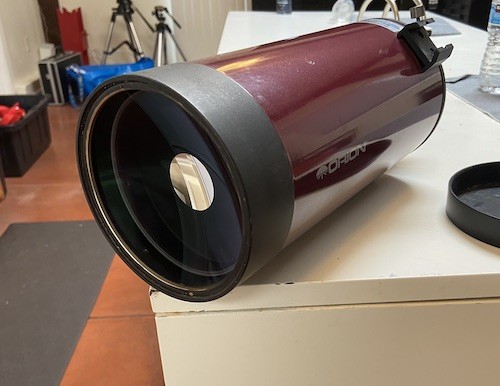
Optics
The Orion Apex 127 is a Maksutov-Cassegrain telescope, nominally a 127mm (5”) f/12 with a 1500mm focal length and f/12 focal ratio. In fact, however, this telescope has an undersized primary mirror around 120mm (4.72”) across, which makes it half an f-stop slower—f/12.5 vs. the f/12 advertised. This is the same as Orion’s StarMax 127, Celestron’s NexStar 127SLT, and the “127mm” Maksutov-Cassegrains sold by Sky-Watcher, as well as any other 127mm f/12 Maksutovs out there.
We wish Orion and the other manufacturers who sell this same telescope could just be honest about this because it’s still a nice telescope otherwise. With 120mm of aperture, you can see a lot of detail on the Moon and planets and do a fair amount of serious deep-sky viewing – though the long 1500mm focal length and nominally 1.25”-only accessories limit the wide-field capabilities of this instrument.
Mechanics
Being a Maksutov-Cassegrain, the Apex 127 seldom needs collimation – though the rear cell has screws if you ever must do so. The optical quality of the Apex, like most Maksutovs, is superb. It is great for lunar, planetary, and double star viewing.
The Apex 127 focuses with the same moving-mirror system most catadioptrics use, and comes with a Maksutov-thread visual back, though you can buy an adapter to use Schmidt-Cassegrain threaded accessories. The 1.25” visual back included has built-in T-threads to attach your DSLR camera. Attaching an SCT-thread adapter and a 2” SCT diagonal will result in some vignetting with wide-field eyepieces thanks to the scope’s narrow baffle tube and undersized primary mirror, but you can still use them to some extent.
Like most telescope optical tubes, the Apex 127 has a Vixen-style dovetail bar with ¼ 20 holes attached so you can either attach it to a Vixen-compatible mount or a heavy-duty photo tripod.
Accessories
As it is sold primarily as a spotting scope and not an astronomical telescope for some reason, the Apex 127 is supplied with a 45-degree erecting prism diagonal. Not only is the 45-degree angled design rather uncomfortable for astronomical use, but the cheap erecting design results in scattering and light loss. You really should replace it with a 90-degree prism or dielectric mirror star diagonal if you plan on using the Apex 127 for any astronomical viewing.
Additionally, the Apex 127 includes an erect-image, straight-through 6×26 finderscope. Like the 45-degree diagonal, it’s really only useful for terrestrial spotting, as the erecting design sucks up a fair amount of the already paltry 26mm of aperture. A quality 6×30 – or even better, 9×50 – straight-through or right-angle finderscope would be much better, and for a primarily planetary/double-star oriented telescope like the Apex a red-dot or reflex sight finder would also work just fine. You can easily swap in a new finder thanks to the StarMax’s industry-standard interchangeable, quick-release finderscope base.
The Apex 127 comes with one eyepiece: A 25mm Sirius Plossl providing approximately 60x. This is fine for low-medium power, but a 32mm or 40mm Plossl eyepiece would probably be better for the lowest-power use and you’ll want at least a couple short focal length eyepieces for high power, where the Apex 127 really excels.
Lastly, the Apex 127 includes a nice soft carrying case for transporting it, a convenient additional touch. The case has just enough room for you to stow a few additional small accessories such as a diagonal, finderscope, and eyepieces, and it’s strong enough to withstand a fair amount of use.
Mount Recommendations
At 8.6 pounds/3.9 kilograms, the Apex 127 is heavy enough that it demands a quality mount, particularly for the high-magnification use it is primarily designed for. An EQ-3 class mount like the Orion AstroView will certainly hold it, but an EQ4 mount like the Celestron CG-4 or Orion SkyView Pro would be even better. An alt-azimuth mount like the Explore Scientific Twilight I or Orion VersaGo II would also work fabulously and is a more convenient and lighter-weight option than an equatorial mount. If you want GoTo, the Sky-Watcher AZ-GTi, Star Adventurer Pro, or EQM-35i, also works (though Sky-Watcher sells this exact telescope as the SkyMax 127 bundled with the AZ-GTi and better accessories).
Should I buy a Used Orion Apex 127?
When looking for a used Maksutov-Cassegrain such as the Apex 127, there are a few checks to be made. Firstly, ensure that the mirror coatings are in good condition and that the corrector is not damage. Secondly, make sure that the focuser moves smoothly – if it is an older scope, you may need to lubricate it, but this should not be too difficult. You may have to collimate a used unit but it isn’t too difficult; our collimation guide has more info on how to do so.
Astrophotography Capabilities
The StarMax 127’s f/12.5 focal ratio doesn’t really lend itself well to astrophotography. A few of my friends and acquaintances have actually done some impressive pictures of the Orion Nebula and some other bright targets with this telescope, but it required an extremely heavy-duty mount and accurate autoguiding in addition to very long exposure times – a fast Newtonian or ED refractor is much, much better for deep-sky astrophotography.
The StarMax 127 does do a pretty good job for lunar and planetary astrophotography. With a 2-3x Barlow, a mount with motorized tracking, and a webcam-style high-speed CMOS camera like the ZWO ASI224MC, you can get high-resolution images of the Moon and planets and amaze your friends and family, in addition to tracking planetary weather patterns and other phenomena.
What can you see?
The Apex 127 is an excellent telescope for lunar, planetary, and double-star viewing. Double stars lack chromatic aberration or diffraction spikes with a Maksutov telescope, and the Apex 127’s sharp optics has no trouble splitting sub-arcsecond pairs when conditions allow. The phases of Mercury and Venus can be seen easily and Mars reveals its polar ice cap most of the time along with any ongoing dust storms. When Mars is close to Earth at opposition, dark markings on the planet’s surface can be seen if atmospheric conditions are favorable. The Moon displays features as small as a few miles wide, while Jupiter’s four moons appear as tiny disks when transiting in front of the planet. Jupiter’s cloud belts have a variety of different colors and the Great Red Spot can be seen amidst them along with other atmospheric details such as storms.
The Apex 127 provides amazing views of Saturn’s rings, and during optimal conditions, the Cassini Division can easily be seen in the rings too. Saturn also has a few dull-colored cloud belts which are also visible, and up to six of its moons can be seen. Uranus and Neptune appear as small turquoise and bluish dots – neither more than a fuzzy “star” in appearance. It is extremely difficult to observe Neptune’s moon Triton with the mere 120mm of aperture provided by the Apex 127, but not impossible. However, Pluto cannot be seen through such a small telescope.
The Apex 127 is not the best choice for viewing deep-sky objects, as its resolving power and light-gathering ability are not sufficient to observe globular clusters or small details in galaxies. Its narrow field of view also impedes larger and brighter targets, such as open star clusters and nebulae. Though certain brighter galaxies, like Andromeda (M31), and groups of galaxies, like the Leo Triplet and Virgo Cluster, may still be visible under ideal conditions, the telescope’s performance will be significantly hampered by light pollution and even under the best skies there just isn’t a lot to see besides bright nebulae like Orion (M42) and some of the smaller open star clusters like M35. For deep-sky viewing a bigger telescope, and preferably one with a shorter focal length and/or 2” eyepiece capability, is a better choice.



Hello Zane, quick question, will you be doing a review of the Orion Apex 102? Or are the two scopes similar enough besides aperture that there’s no need?
I’m interested in picking one up as a grab and go.
Get the 127, mounting requirements are basically the same but it’ll show a lot more.
Thanks for the reply, I’d love to get the 127 but the 102 is being sold for a ridiculous price, and it all looks legit. It’s priced good enough that I can’t ignore it!
So do you think the quality of it will be good, minus the obvious differences due to aperture etc? Not sure if you have used one or heard anything about them in your travels.